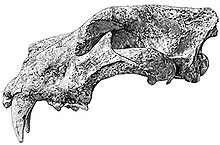Panthera fossilis
| Panthera fossilis Temporal range:
| |
|---|---|

| |
| Skull from Azé, France | |

| |
| Life restoration | |
| Scientific classification | |
| Domain: | Eukaryota |
| Kingdom: | Animalia |
| Phylum: | Chordata |
| Class: | Mammalia |
| Order: | Carnivora |
| Suborder: | Feliformia |
| Family: | Felidae |
| Subfamily: | Pantherinae |
| Genus: | Panthera |
| Species: | †P. fossilis
|
| Binomial name | |
| †Panthera fossilis (Reichenau, 1906)
| |
| Synonyms | |
| |
Panthera fossilis (also known as Panthera leo fossilis or Panthera spelaea fossilis), is an extinct species of
Discoveries
It was first described from remains
Evolution
P. fossilis is estimated to have evolved in Eurasia about 600,000 years ago from a large pantherine cat that originated in the Tanzanian Olduvai Gorge about 1.2–1.7 million years ago. This cat entered Eurasia about 780,000–700,000 years ago and gave rise to several lion-like forms. The first fossils that can be definitively classified as P. fossilis date to 610,000 years ago. Recent nuclear genomic evidence suggest that interbreeding between modern lions and all Eurasian fossil lions took place up until 500,000 years ago, but by 470,000 years ago, no subsequent interbreeding between the two lineages occurred.[9][8]
Characteristics
Bone fragments of P. fossilis indicate that it was larger than the modern lion and was among the largest cats. Skeletal remains of P. fossilis populations in Siberia measure larger than those in
Taxonomic history
P. fossilis was historically considered an early
Results of
Palaeobiology
This lion coexisted with early humans and prehistoric fauna.[16] A mandible from the early hominid Homo heidelbergensis was excavated in 1907 at Mauer, Germany.[17]
See also
References
- S2CID 243319924
- .
- ^ S2CID 251855356.
- ^ Reichenau, W. V. (1906). "Beiträge zur näheren Kenntnis der Carnivoren aus den Sanden von Mauer und Mosbach". Abhandlungen der Großherzoglichen Hessischen Geologischen Landesanstalt zu Darmstadt. 4 (2): 125.
- .
- . Retrieved 22 March 2024 – via Elsevier Science Direct.
- ^ .
- ^ PMID 24382145.
- PMID 32366643.
- ^ PMID 15012963.
- ISSN 1064-7554. Retrieved 22 March 2024.
- .
- .
- .
- hdl:10576/22920.
- ^ ISBN 978-1861897350.
- ^ Schoetensack, O. (1908). Der Unterkiefer des Homo heidelbergensis aus den Sanden von Mauer bei Heidelberg. Ein Beitrag zur Paläontologie des Menschen. Leipzig: Engelmann.
